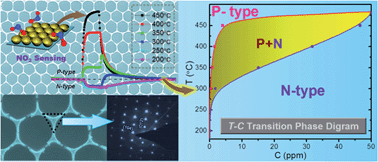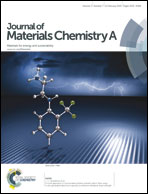Highly reversible switching from P- to N-type NO2 sensing in a monolayer Fe2O3 inverse opal film and the associated P–N transition phase diagram†
Abstract
The detection of nitrogen dioxide, NO2, is currently the subject of extensive scientific and technological research, motivated by its deleterious impact on the environment and on human health and safety. However, detecting trace levels of NO2 gas in a timely, sensitive, and selective manner remains challenging, while the mechanisms governing selective NO2 sensing are still unclear. In this work, a monolayer α-Fe2O3 inverse opal (IO) film with single-crystalline 3-fold rotocenters is firstly synthesized in situ on a substrate using a sacrificial template and evaluated as a sensitive NO2 chemiresistor. Interestingly, the Fe2O3 macroporous film manifests abnormal sensing behavior with reversible transitions from p- to n-type sensing as a function of the NO2 concentration (C) and working temperature (T). Based on more familiar phase diagrams, a binary (T–C) transition diagram has been created in terms of the gas sensing response, which can be directly used to design and control the p–n transitions. Further investigations also show that such abnormal p–n transitions do not occur if a different sensing material (e.g. SnO2 IO) is used, or on exposure to gases other than NO2. The porous Fe2O3 sensor is capable of detecting trace levels of NO2, as low as 10 ppb, and shows good stability. Finally, the mechanisms underlying the unusual NO2 sensing transitions are described based on the nature of the materials and the well-known Lennard-Jones model. Reversible switching from p- to n-type sensing and the associated transition diagram carry great potential for the recognition and sensitive detection of trace levels of NO2.


 Please wait while we load your content...
Please wait while we load your content...